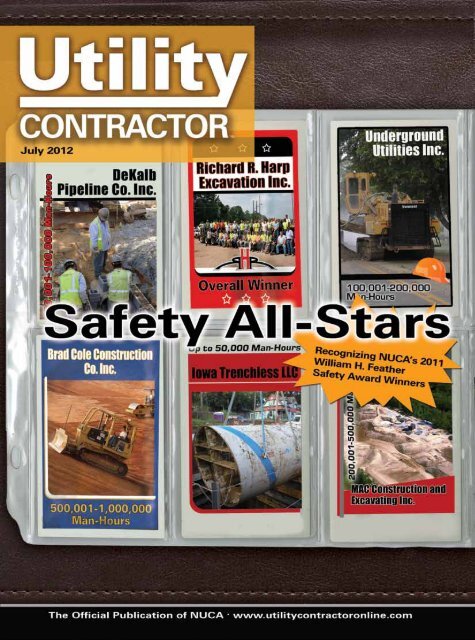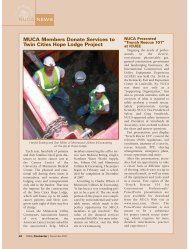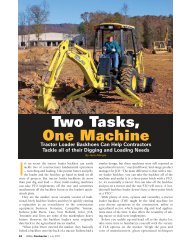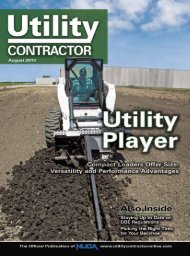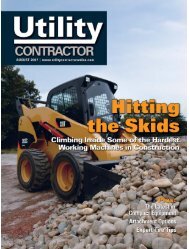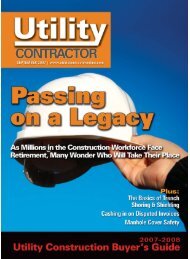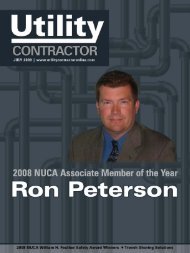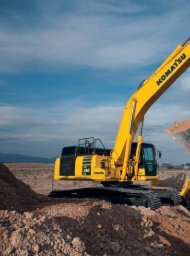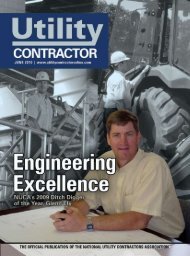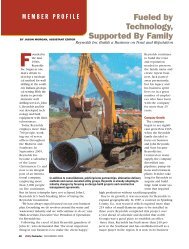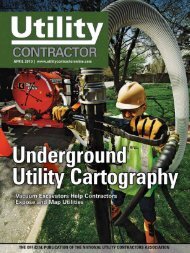View Full July PDF Issue - Utility Contractor Magazine
View Full July PDF Issue - Utility Contractor Magazine
View Full July PDF Issue - Utility Contractor Magazine
Create successful ePaper yourself
Turn your PDF publications into a flip-book with our unique Google optimized e-Paper software.
groundbreaking newsIn early 2011, Volvo Rents set a course tonot only operate a franchise network of rentalcenters, but also manage and grow a networkof company-owned stores. And while thebulk of Volvo Rents’ growth has been throughthe acquisitions of independently-ownedconstruction equipment rental companies, theopening of new stores has played an integralrole in the company’s expansion strategy.In the last six months, Volvo Rents has openeda total of 10 new rental centers throughoutNorth America, including nine in the UnitedStates and one in Canada.“Yes, acquisitions have been a great way forus to expand our North American footprint,but it’s not the only way,” said Mike Crouch,Vice President of Business Development forVolvo Rents. “We have taken decisive steps tohelp our business grow and succeed throughmultiple strategies, and it is these strategies thatseparate us from our competitors and furtherdistinguish us as the leader in the constructionequipment industry.”In addition to an expanding line of Volvocompact equipment — such as backhoeand skid steer loaders, compact wheelloaders, compact excavators and compactionequipment — Volvo Rents stores carry acomprehensive line of essential equipmentand tools for the construction, commercial,industrial and homeowner markets. The focusis on daily, weekly and monthly rentals.According to Crouch, the opening of thesenew stores comes at a perfect time, as therecession continues to force contractors to befinancially prudent.“Currently, the U.S. is undergoing anunprecedented shift from buying equipmentto renting,” he added, noting that constructionequipment rental revenue grows an average ofseven percent annually. “This puts us in a veryfavorable position as we continue to grow invarious markets across the country.”Since implementing the strategy in 2011, VolvoRents has acquired 21 construction equipmentrental companies (13 in 2011 and eight sincethe beginning of this year), totaling 49 locations.Over the last two years, Volvo Rents has acquiredconstruction equipment rental companies in 13states: seven in California; three in New Mexico;three in Kansas; five in South Carolina; one inFlorida; four in Oklahoma; three in Missouri; onein Illinois; three in Wyoming; one is Arizona; threein Utah; three in Louisiana; and one is Wisconsin.That doesn’t even include acquisitions of formerfranchisees. Volvo Rents also acquired a sixlocationconstruction equipment rental companyin Ontario, Canada, and has more acquisitionsplanned for this year.“I think our strategy is based around where ourcurrent customers are taking us,” says Tavianini.“We had a large amount of our customers in therecession period that expanded their footprint.Now we need to expand our footprint to cover8 <strong>Utility</strong> <strong>Contractor</strong> | <strong>July</strong> 2012
groundbreaking newsthose services as well. Obviously,anywhere where there are energyservices involved is very intriguing atthis point, but that doesn’t mean that’sall we’re focusing on. We’re letting ourcustomers drive our expansion — that’sour philosophy.”Today, Volvo Rents has 117 locationsaround America. It should be noted thatVolvo Rents and the Volvo ConstructionEquipment (CE) dealership are twoseparate entities. Volvo Rents actuallybuys equipment direct from Volvo CE,along with buying and renting non-Volvo manufactured products likeaerial lift machines, generators, materialhandlers, light towers and onward.Volvo Rents concentrates on the utilityand earth moving markets, with aspecial focus on renting compact andlight construction equipment.In the last six months, that nationalrental chain has opened a total of 10new rental centers throughout NorthAmerica, including nine in the UnitedStates. The strategy makes perfect sense.The American construction industry iscurrently undergoing an unprecedentedshift from buying equipment torenting. There’s an uncertainty in theconstruction market because of thelack of long-term funding to local andnational projects and an uneven backlogfor upcoming jobs.“There’s still a lot of instability withinthe construction industry, and the rentalindustry can benefit a little from thatinstability,” explains Tavianini. “I thinkthe backlog of work isn’t there like it wasfour years ago, and that rental industrytends to benefit from that. I wish it wouldbe the other way around. Every recessionwe go through, the rental industry is thefirst to come out.”Call of DutyCheck Out JCB’s Purpose-Built Excavator for the U.S. ArmyAlthough you may not see JCB’s HMEE (High Mobility Engineer Excavator) on anyjobsites around the neighborhood, we wanted to give you a look at a backhoe built forthe U.S. Army. The HMEE is designed to provide battlefield commanders with a myriad oflogistics capabilities in front patrols. It incorporates three characteristics essential for militarysuccess: 1) Mobility — Able to traverse rough terrain, the HMEE can create roads for militarypassage under almost any conditions; 2) Counter-mobility — The strong, nimble HMEE isa whiz at creating obstacles to foil the enemy; and 3) Survival — By providing an invaluableasset to soldiers in the field.The JCB HMEE is the world’s fastest backhoe loader, traveling at speeds up to 60 mphon both paved road and cross-country surfaces. Weighing approximately 17.55 tons witharmor and 15.75 tons without armor, the four-wheel drive, four-wheel steer machine witha 6.7-liter diesel engine can lift more than 2.2 tons and dig a depth of almost 13 ft.The JCB HMEE is the result of a four-year program of design, development andtesting and was built specifically for the U.S. military as a replacement for theirSmall Emplacement Excavator (SEE). The majority of the JCBteam producing the HMEE has served in the military, uniquelyqualifying them to produce and maintain this exceptionalvehicle for the end customer — the soldier in the field. To learnmore, scan this QR code with your smartphone to watch a video.Volvo Rents is definitely benefiting froma revamped line of Volvo skid steers andtrack loaders. These units come with aunique one-armed boom design.<strong>July</strong> 2012 | <strong>Utility</strong> <strong>Contractor</strong> 9
groundbreaking newsThe Perfect BlendLee Supply Acquires J.P. McElvenny Co.Lee Supply, a leader in the sale and markets they serve. In addition toinstallation of pipe and pumping serving current J.P. McElvenny Co.systems, is getting bigger and better. customers, the Downingtown locationMichael H. Lee, President of the will logistically enhance servicecompany, recently announced theacquisition of J.P. McElvenny Co.Inc. located in Downingtown, Pa. J.P.McElvenny Co. has been in businessfor more than 30 years, and its founderJohn McElvenny Jr. was a pioneer inoperations to the Northeastern region.The J.P. McElvenny Co. divisionof Lee Supply will be able to providea total package to its customers byoffering a full line of HDPE products,McElroy fusion equipment, Electrothe introduction of HDPE pipe and Fusion equipment, fittings andfittings to the industrial market.The cultures of the two companies —both being closely held, family ownedand independent — provided a perfectopportunity to bring together theirmutual commitment to providingquality products and services to thefusion training and certification, toname a few.The management team of JohnMcElvenny III, Rich Mueller and PattiMueller will remain in place as part ofthe Lee Supply Team. They bring manyyears of HDPE experience and certainlyLee Supply recently announced theacquisition of J.P. McElvenny Co. Inc.represent the Lee Supply philosophyof “Quality People, Quality Products,Quality Service.”Fighting CrimeVermeer Launches Equipment Registration Program with NER to Combat Machine TheftEquipment thieves — consideryourselves warned. The NationalEquipment Register (NER), a leadingsource of information about equipmenttheft risk, has announced a data sharingarrangement with Vermeer to helpVermeer customers combat equipmenttheft. NER is a division of the Verisk CrimeAnalytics unit at Verisk Analytics.NER operates a national database ofequipment theft and ownership reportsto help law enforcement identify theowners of equipment suspected to bestolen. Through the database, more than45 million pieces of stolen equipmenthave been recovered. By registering allnew underground utility installation,tree care and agricultural equipment, aswell as providing a historical downloadof equipment manufactured over the last20 years on NER’s HELPtech database,Vermeer is offering a valuable service to itsclients.This arrangement will enhance thelikelihood that law enforcement canquickly identify the true owner ofa Vermeer machine 24 hours a day.HELPtech registrationdecals further mitigate riskthrough deterring theft.“We believe that thisrelationship is one moreway to serve our Vermeercustomers better,” statedLois Slings, ProductLiability Risk Manager atVermeer.“By providing newpoint-of-sale data and thehistorical download ofequipment sold, Vermeeerhas taken a proactive step tohelp its clients protect their assets,” addedRyan Shepherd, Operations Manager atNER. “Because of this step, it just becamea riskier proposition for criminals to stealor try to sell stolen Vermeer equipment inthe used market.”Vermeer has partnered with NER to help itscustomers combat equipment theft.10 <strong>Utility</strong> <strong>Contractor</strong> | <strong>July</strong> 2012
groundbreaking newsSafety FirstVISTA Offers <strong>Utility</strong> Gas Meter Change-Out Safety VideoVISTA Training Inc. is bringing safety to explained VISTA Training CEO Brucea DVD player near you. The company has Rabe. “We especially like the fact that therecently formed a strategic partnership safe work practices CARGI recommendswith the Consortium for Advanced are based on extensive field data collectedResearch in Gas Industries (CARGI) at the and analyzed by its staff. That bringsUniversity of Wisconsin-Milwaukee to bethe exclusive sales agent for its gas meterchange-out safety video.some valuable real-world credibility to itsrecommendations.”For more information about theGas Meter Change-Out Guide, visitwww.vista-training.com.The “ProtectingYourself fromInjuries: GasMeter Change-Out Guide”safety video isnow availablethrough VistaTraining.The “Protecting Yourself fromInjuries: Gas Meter Change-Out Guide”safety video was developed by CARGIspecifically for gas utility employees andcontractors. It describes the best waysto prevent injuries while performingresidential and industrial/commercialgas meter installation, service and repair.CARGI developed this safety trainingprogram as a result of a research project itconducted to identify the most commontypes of injuries that can occur duringgas meter change-outs — including back,neck and knee pain. The video outlinessafe work practices to help workers avoidsuch injuries.CARGI is dedicated to improvingergonomics, safety, productivity andquality in the gas and related utilityindustries.VISTA Training provides trainingsolutions for people involved inearthmoving, excavating, utility andmining applications. It’s “Start Smart”slogan is well-recognized and respectedin the construction, municipal and utilityindustries, which VISTA has served formore than 20 years.“The Gas Meter Change-Out Guide isan excellent complement to our productline, which already includes a number oftraining programs we developed for theNational <strong>Utility</strong> <strong>Contractor</strong> Association,”<strong>July</strong> 2012 | <strong>Utility</strong> <strong>Contractor</strong> 11
groundbreaking newsMoving OnRobert Westphal RetiresAfter a Successful Career in<strong>Utility</strong> ConstructionIndustry leader Robert Westphalretired on <strong>July</strong> 1 after a decorated careerat Michels Corp. and in the utilityconstruction industry.Westphal started with Michels as alaborer in 1965 when he was directlyhired by company founder DaleMichels. He worked his way throughthe ranks as operator, foreman, projectsuperintendent, general superintendent,Robert Westphalretired on <strong>July</strong> 1after a decoratedcareer in the utilityconstruction industry.vice president and, finally, senior vice president of constructionoperations. After retirement, Westphal will continue to play anintegral role with the Brownsville, Wis.-based utility constructioncompany when he transitions into a new role of senior strategicadvisor by continuing to help Michels maintain and developcustomer relationships and continuing to provide keenly acquiredknowledge and business acumen to Michels’ future and growth.Providing positive leadership has been a hallmark of Westphal’scareer. In 1980, future Michels President Pat Michels came to workfor Westphal on a water project he was leading in South Dakota.The two developed a friendship and respect for one another whichcontinues to thrive today. Both remain committed to respecting thecompany roots while keeping a keen eye trained on future growth.“Bob has been critically important to my family and MichelsCorp. for more than 47 years,” said Pat Michels, Michels President.“He has seen a tremendous amount of growth at Michels and hasbeen an integral part in helping to evolve the company into thesuccess it is today.”Westphal was heavily involved in the telecommunications boomof the 1980s and, from that arena, helped found and shepherdMichels’ now globally renowned directional drilling operation.He was also instrumental with guiding the company through theresurgence of its mainline pipeline operations.Spending his career at Michels was an easy decision for Westphal.“I always had the sense that there would be continuousopportunity for growth, not only from the company’s standpointbut for myself and that has continued throughout my career,”he said. “I have had opportunities to work with many incrediblytalented people throughout the organization during the courseof my time here.”Horizontal directional drilling, micro-tunneling, pipelineconstruction and pipe rehabilitation encapsulates the diversefields of underground utility construction for which Westphalhas earned himself a highly regarded reputation.Westphal has remained actively involved in many relatedassociations which have played an invaluable role in helpinghim stay in tune with rapidly changing technology, industriesand markets.Get to WorkOpportunities in <strong>Utility</strong> ConstructionConference Set for Oct. 9-10 inWilmington, OhioWhile the decline in the housing market has hada profound effect on the utility construction marketover the last several years, there has still beenemerging opportunities for enterprising contractorswilling to look into new fields. To help identifythese emerging areas, as well as to provide tools andstrategies to be successful in these areas, BenjaminMedia Inc. (Publisher of <strong>Utility</strong> <strong>Contractor</strong>) is hostingthe Opportunities in <strong>Utility</strong> Construction Conferencein conjunction with its Trenchless Technology RoadShow Oct. 9-10 in Wilmington, Ohio.The regional conference is dedicated to helpingcontractors in Ohio, Indiana, Kentucky, Pennsylvaniaand West Virginia discuss market opportunities inutility construction. New business opportunitiesto be explored include shale drilling, solar powerconstruction, wind power construction, geothermalconstruction, microtrenching, undergrounding ofutilities, site prep and more. In addition, tracks onequipment and management strategies will be presentedto help contractors achieve optimal efficiency.The Trenchless Technology Road Show, presented asa track with the Opportunities in <strong>Utility</strong> ConstructionConference, features topics covering pipe relining,manhole repair, grouting, horizontal directional drilling,microtunneling, pipe inspection and more — all presentedby recognized industry experts. The trenchless marketfor repairing and installing underground utilities,particularly sewer and water pipelines, has been a brightspot in an otherwise gloomy construction market.Trenchless techniques have continued to improve andgain market share vs. open-cut techniques. For morethan 15 years, the Trenchless Technology Road Showshave provided presentations on trenchless processesthat keep vital infrastructure up and running withminimal disruption.For additional information on the Opportunities in<strong>Utility</strong> Construction Conference, contact Benjamin Mediaat (330) 467-7588 or visit www.oucconference.com.12 <strong>Utility</strong> <strong>Contractor</strong> | <strong>July</strong> 2012
Partners inInfrastructureHD Supply Waterworks Is NamedNUCA’s 2011 Associate of the YearBy Pam KleinekeFor utility contactors to gettheir work done, they needthe right pieces and parts forthe tasks at hand. Aside fromtheir heavy equipment, these crewsrely on pipe, valves, fittings and othermaterials to construct and fix theinfrastructure that lies beneath. That’swhere companies like HD SupplyWaterworks (HDSWW), a distributorof water, wastewater, storm and fireprotectionproducts, come into play.“In the industry we serve, theproducts that we distribute are integralto building, repairing and maintainingwater and wastewater systems,” saysJerry Webb, CEO of HD SupplyWaterworks. “These products are a partof the basic infrastructure required tosupport population and economicgrowth, as well as residential andcommercial construction.”HD Supply Waterworks beganin 2005 through the acquisition ofNational Waterworks by The HomeDepot and grew significantly in 2006through the acquisition of HughesSupply. Today, HDSWW is one of the14 <strong>Utility</strong> <strong>Contractor</strong> | <strong>July</strong> 2012nation’s largest distributors of water,sewer, storm and fire-protectionproducts, boasting 240 locations and2,300 employees in 44 states.“Our strength is our people,” saysWebb. “We have an outstanding teamof managers and sales reps with some ofthe longest tenures in the industry and apassion for customer service. With ourdepth of knowledge and desire to serve,our customers can rely on our team asa trusted business partner. In this everchangingindustry, our comprehensivestate-of-the-art technology services,market-specific initiatives and seamlessback office operations keep HD SupplyWaterworks the top choice for ourcustomers’ water, sewer, storm andfire-protection needs.”Another ingredient to HDSWW’ssuccess is keeping its product line freshand ahead of trends in the industry.In an effort to do this, the companydepends on a strategic researchand development (R&D) campaigndesigned around supplying products toserve its customers’ needs. “Our R&Defforts are designed to keep us ahead ofindustry specifications by proactivelyworking with both our customersand manufacturers to anticipate andaddress future needs,” says Webb. “Wealso continuously look for innovativeproducts and services that will savetime and money for our contractorcustomers and the end-users.”A Natural PartnershipThrough all of the previous companyentities, HDSWW has been a lifelongmember of NUCA, hoping to connectwith its clientele and benefit from whatthe association has to offer. For morethan four decades, NUCA has been thelargest and most influential nationaltrade association working solely forthe excavation and underground utilityconstruction industry.“The NUCA organization representsthe largest segment of our customerbase — underground utility contractors,”explains Webb. “NUCA’s voice inWashington, D.C., helps to transformthe future of the industry where wedistribute our products.”Through its time with NUCA, the
company has seen the influence andbenefits of the association firsthand.Whether it’s lobbying Congress oroffering safety training, NUCA’s sightsare set on promoting the well-beingand success of its members and theindustry. “We have learned that astrong national organization can play asignificant role in helping address ournation’s water and wastewater needs,”says Webb.Over the years, HDSWW has lentits support for various NUCA events.For example, in March, the companysponsored Former First Lady LauraBush’s talk at the NUCA Convention.It has also sponsored the Convention’sCyber Café for many years. “Oursupport of the Cyber Café was tohighlight our focus on bringingtechnology solutions to undergroundcontractors,” says Webb. “Our supportof the Laura Bush speech was our effortto bring timely, relevant and interestingspeakers to the NUCA organization.”In 2012, NUCA launched itsNational Partners program, enablingits associate member companies topublicly show their support for theassociation. HDSWW took advantageof the opportunity and became aGold National Partner — a move thecompany felt was a no-brainer.“We have always been a supporter ofNUCA on both the local and nationallevel,” says Webb. “Taking the nextstep to Gold National Partner was anatural next step in this partnership.”As another way to supportNUCA, HDSWW works to promoteJerry Webb, CEO of HD SupplyWaterworks, receives the 2011Associate of the Year award fromNUCA Chairman Ryan Schmitt.<strong>July</strong> 2012 | <strong>Utility</strong> <strong>Contractor</strong> 15
membership among its colleagues. Webb says, “Weencourage our suppliers, as well as our contractors, tobe members of an organization whose sole purpose is tosupport underground construction.”To honor the company’s many years of support andhighlight its service to the industry, NUCA named HDSWWits 2011 Associate of the Year — an award everyone inthe company was honored to receive. This distinction ispresented annually at NUCA’s Convention to an associatemember who has made a significant contribution to theassociation and the underground utility construction andexcavation industry as a whole.“The Associate of the Year award means a great deal to ourorganization because it is recognition by our customers ofour value to the industry,” says Webb. “Our entire team washonored and excited about the announcement of this award.”While it’s difficult to pinpoint any one person or groupvaluable to HDSWW’s success, Webb says that the NUCAorganization and its affiliate members have certainly playeda significant role in the company’s accomplishments andreceipt of the award.Looking AheadAs 2012 continues on and the industry looks to thefuture, Webb says that the company is optimistic. “Theunderground utility market has improved somewhatthis year over the previous three years and we maintainour view that the outlook is promising for this year andbeyond,” he says.Despite a positive outlook, Webb mentions that thereare some significant obstacles for the industry and itsprofessionals to manage. Perhaps the largest one is funding.In order for work to be done, the proper investment ininfrastructure needs to be made.“Most of the challenges are related to funding formunicipal, private and commercial construction, most ofwhich are related to the current economic challenges,” hesays. “The No. 1 challenge related to the current market isfunding for both the public and private sectors.”With a bright future ahead and plenty of opportunityto grow, HDSWW has expansion on its mind. By beingproactive in the industry, the company can capitalize onnew markets and get its name out to new customers.“Our goal over the next five years is to continue to expandgeographically, while continuing to add products and servicesthat will help meet the emerging needs of our customer base,”says Webb. “We will continue to look for those areas wherewe can be the distributor of choice for our customers.”Pam Kleineke is Associate Editor of <strong>Utility</strong> <strong>Contractor</strong>.Today, HD Supply Waterworks is one of the nation’s largest distributors of water, sewer, storm and fire-protection products, boasting240 locations and 2,300 employees in 44 states.16 <strong>Utility</strong> <strong>Contractor</strong> | <strong>July</strong> 2012
SAFE!(at work)Recognizing NUCA’s 2011 William H. FeatherSafety Award WinnersBy Pam KleinekeSafety is a team effort and requireseveryone’s cooperation for a winningresult in the field. Jobsites offerplenty of opportunities for accidentsand injuries, so adhering to proper safetyprocedures during a project should be No. 1 in acompany’s game plan. By developing structuredsafety programs and reinforcing safe practicesto employees, companies can rest assured thattheir crews are prepared for whatever a jobmay throw at them. These skills and policiestranslate into each crewmember going homeunharmed after the day is done — and that’s ahomerun for everyone.To recognize the all-star companies that strivefor safety and the general well-being of theiremployees, NUCA awards six companies withthe William H. Feather Safety Award. Who isWilliam H. Feather you ask? He was the veryfirst chairman of the Safety Committee andwidely regarded as the backbone of NUCA’searly safety initiatives. He was honored for hismany contributions to the association in 1976when he was named Ditch Digger of the Year,but his premature passing led NUCA to searchfor some additional way to commemorate hispassion for safety. At NUCA’s 1978 conventionin New Orleans, a new award was created torecognize those contractors that exemplify Mr.Feather’s commitment to a safe workplace.The awards are given to companies basedon incidence rate (OSHA 300 log), companysafety statement and company safety programinformation. Participation in NUCA safetyprograms and activities is also taken intoconsideration. The 2011 William H. FeatherSafety awards were given out at the NUCAWashington Summit this past May. Check outthe MVPs of safety over the next four pages.Up to 50,000 Man-HoursIowaTrenchless LLCFounded: 2002Location: Panora, IowaRoster: 19Services: Augerboring, pipe ramming,pipe bursting, pipejacking, microtunneling, rock boring and tunnelingChapter: NUCA of IowaDedication to Safety: Following the approach “Think first,act second and always be prepared,” Iowa Trenchless’ principalgoal is that every employee goes home each day without injury.Education is an important part of its safety program, and eachemployee participates in OSHA 10-Hour, Excavation Safety andCompetent Person, Confined Spaces Entry and CPR/First Aidtraining. Employees also have a great safety resource leadingthe way. Company President Jason Clark is a NUCA-certifiedOSHA Confined Spaces Entry and Competent Person trainer.According to the company, employees are motivated to worksafely, both for their own personal well-being and for that oftheir coworkers. Iowa Trenchless evaluates its employeesthroughout the year — with an emphasis on safety competencyand safe practice procedures — and rewards them accordingly.The company says it continually benefits from its NUCAmembership thanks to great resources such as updates insafety training, industry standards and requirements.Pam Kleineke is Associate Editor of <strong>Utility</strong> <strong>Contractor</strong>.18 <strong>Utility</strong> <strong>Contractor</strong> | <strong>July</strong> 2012
DeKalb Pipeline Co. Inc.Founded: 1960Location: Conyers, Ga.50,001-100,000 Man-HoursRoster: 28Services: Complete turnkeysite development and utilitiesconstruction services, fromgrading through completionand follow-upDedication to Safety:Safety is a top priority foreveryone at DeKalb PipelineCo. Despite dealing with hardeconomic times and workingleaner, the company knows safety is not something that canbe negotiated or ignored. From day one with the company,new employees are required to listen to the “New EmployeeSafety Orientation” tape that’s provided in both English andSpanish. DeKalb Pipeline also makes safety a constant topicamong its workforce through participation in weekly Tool BoxTalks, monthly safety videos and drug awareness meetings. Thecompany says its dedication to safety reinforces its employees’commitment to staying safe on the job and it gives them a senseof comfort knowing the company cares about their well-being.As for its NUCA membership, DeKalb Pipeline mentions thatthe association helps the company achieve its safety goals byoffering great training outlets to sculpt well-rounded employees.Since 1997, the company has received the William H. FeatherSafety Award nine times.Underground Utilities Inc.100,001-200,000 Man-HoursFounded: 1978Location: Monroeville, OhioRoster: 90-95Services: Sewer andwater construction,excavation and sitedevelopmentChapter: NUCA of OhioDedication to Safety:Safety is No. 1 at UndergroundUtilities Inc., and thecompany makes sure to getthe message across to eachand every one of its employees.Once a year, the company holds an annual safety seminarwhere an entire day is devoted to training. UndergroundUtilities also publishes a monthly newsletter for its staff andtypically dedicates 50 to 65 percent of it to employee safetyissues. To further emphasize the importance of safety to itscrew, the company frequently sends out memos to all employeesregarding different safety issues. Feedback is alsowelcomed at the company as a way to communicate safetyconcerns and ways to promote a safe work environment.Management encourages its employees to discuss waysto work safer and offer tips to coworkers. According to thecompany, personal protective equipment (PPE) is readilyavailable — all an employee has to do is ask.<strong>July</strong> 2012 | <strong>Utility</strong> <strong>Contractor</strong> 19
MAC Constructionand Excavating Inc.Founded: 1980Location: New Albany, Ind.200,001-500,000 Man-HoursRoster: 250Services: Site development, structural concreteconstruction, highway and bridge construction, streetscaperenovation and asphalt pavingChapter: NUCA of IndianaDedication to Safety: Managed by a degreed safetyengineer, MAC Construction and Excavating’s safety programencompasses all of the company’s services in one, informativeplatform. Its written program contains approximately 38 policiesalong with pertinent forms and checklists, says the company.Education acts as the backbone of MAC’s safety program,with employee orientation, continual onsite workforce trainingand continuing education for supervision and managementall playing an important role. Safety begins immediatelyfor MAC employees — starting with attending a four-hourorientation covering personal instructions on the requirementsof the corporate program. More than a dozen companytraining programs are used throughout the year to educateMAC’s workforce and include a variety of topics including fallprotection and confined space, to name a few. The companyoffers these programs at both the “User” and “CompetentPerson” level. Continuous education is a requirementfor MAC employees with opportunities suchas NUCA certifications and up to 15 additional hoursof safety training.Brad Cole ConstructionCo. Inc.Founded: 1972Location: Carrollton, Ga.Roster: 200+20 <strong>Utility</strong> <strong>Contractor</strong> | <strong>July</strong> 2012500,001-1,000,000 Man-HoursServices: Sitework,land clearing, grading anddrainage workDedication to Safety: Brad Cole Construction’s(BCC) safety program begins with zero — Target Zero.The company’s Target Zero philosophy strives for agoal of zero accidents, injuries or job-related healthissues on every job. With high value placed on thesafety of its crew, BCC is committed to providing asafe workplace by identifying and eliminating hazardsthat may develop during the work process. All threegroups of the company — employees, supervisors andmanagement — are expected to take part in its safetyculture. According to BCC, employees are requiredto comply with all company safety rules, federalregulations and safe work practices. The daily duties ofsupervisors include checking the workplace for unsafeconditions, observing employees for unsafe acts andtaking prompt actions to eliminate any hazards. BCC’smanagement devotes the necessary resources forsite safety committees and a corporate safety steeringcommittee — both designed to aid in the promotion ofsafe practices throughout the company.
Services: Turnkey site development including clearing, demolition, grading and pavingRichard R. HarpExcavation Inc.Founded: 1990Location: Fayetteville, Ga.Roster: 80+Overall WinnerDedication to Safety: With the simple sentiment “Safety Is an Attitude,”Richard R. Harp Excavation has made safety a priority among its employees —implementing and enforcing a sound written safety program. Safety is a No. 1priority at the company, whose policy is to provide a work environment that isfree of hazards that may affect the safety and health of its employees. Keeping upwith this policy is a shared responsibility within the company; both employeesand management are expected to recognize unsafe conditions and take steps tocorrect any deficiencies. Each member of management has made a commitmentto ensure that safe conditions will be presented and maintained at all jobsites.Aside from everyone’s cooperation, the company relies on its management toensure high morale among the employees by encouraging and appreciating thestaff. The safety program, coupled with an impeccable safety record, has meantbig savings for the company. In 2011, it received a three-year total savings of$193,225 through schedule and experience credits in Worker’s Compensationpremiums, says the company. Richard R. Harp Excavation also takes time topraise its employees who are complying with the safety program. For example,the company holds an annual safety appreciation day.At the event, employees with zero safety violations and/orno moving violations receive a safety award. There are alsoseveral prizes and guest speakers to enjoy.<strong>July</strong> 2012 | <strong>Utility</strong> <strong>Contractor</strong> 21
Making Safety a Shore ThingFactors to Consider when Purchasing Trench Shoring and Shielding SystemsBy Debbie SnidermanThe United States Occupational Safety and HealthAdministration (OSHA) requires a protective systemsuch as sloping, shielding or shoring for any trenchor excavation deeper than 5 ft. Shields and shoringdevices protect workers and stabilize the soil around nearbystructures or foundations, which can help reduce restorationand cleanup costs.Shoring is the act of supporting walls to prevent acollapse, and it can be passive or active. Trench shields or“trench boxes” passively protect workers within the shield.Shores actively prevent trench walls from collapsing byapplying hydraulic pressure to them. Projects for stateDepartments of Transportation or other governmententities typically require active shoring, so nothing in thevicinity of the excavation is compromised. <strong>Contractor</strong>shave many options for purchasing or renting shieldingand shoring systems.Trench Boxes and Traditional ShieldsConventional trench boxes are a static form of shielding.They are steel side-walled boxes with a cross-memberspreader pipe for support. Trench boxes are installed after ahole is dug and before a worker enters.Manufactured trench shields are rated for a given depthand soil condition and are made from steel or aluminum.James McRay, Director of Marketing and Media at EfficiencyProduction Inc., says, “<strong>Contractor</strong>s can design protectivesystems for depths up to 20 ft. If deeper, contractorsmust use systems designed by a registered professionalengineer licensed in the state where work is performed ora manufactured protective system that is in accordance withthe manufacturer’s tabulated data. Using a manufacturedshield removes the guesswork.”Manufactured trench shields come with features and optionsthat help when working around utilities already installed in22 <strong>Utility</strong> <strong>Contractor</strong> | <strong>July</strong> 2012
the path of a trench. Cutouts in the shield sidewalls — orspecifically designed trench boxes like a manhole shield —accommodate many types of cross utilities.Efficiency Production, one of the largest manufacturersof trench shoring and shielding equipment, also makes amodular and flexible trench shielding system. Build-a-Box has aluminum panels and corner posts that users canassemble in different configurations. They can stack asmany high as needed or form a three- or four-sided box byclosing off one or both ends.This system is popular since users can handle andinstall it with smaller excavation equipment such as amunicipal backhoe. Its flexibility works well in cities andother congested areas, making it a popular choice formunicipalities, McRay says.Vertical Hydraulic Shoring SystemsVertical hydraulic shores also ensure worker safety insidetrenches. They consist of a pair of 8-in. aluminum railsconnected by hydraulic cylinders. <strong>Contractor</strong>s pressurize thehydraulic cylinders outside of the trench with a hand-pumpusing environmentally safe shoring fluids composed mainly ofwater. Hydraulic cylinders are designed to stay pressurized andactively shore a trench for long periods of time, McRay says.Trench boxes, such as this one from National TrenchSafety, are installed after a hole is dug and before aworker enters.Taking CareHow to Avoid Errors in the FieldWhen installing aluminum shoring, it’s important to takecare of the pieces and parts of the system. “They are madefrom the same 6061 aluminum used in aircraft, which isdurable but can’t take a lot of abuse,” says Dan Williamson,National Sales Manager for Cerda Industries, a trenchshoring and shield equipment manufacturer. “Improperuse, like aggressive tamping or hitting during installation,can damage the products, and rental houses would wantto be reimbursed for that. Cerda changed the name of its‘pounding pads’ to ‘push pads’ to better communicate thecare with which the shores should be installed.”Shields can weigh more than 20,000 lbs, so it is importantto use updated rigging equipment. Williamson recommendsthat contractors inspect their slings, nylon straps, wire cablesand chains and ensure they are rated for the capacity of whatthey will handle. Some require inspection tags annually. Asling or bridal company measures each link to see if it hasstretched beyond a specification and removes those fromservice for repair or replacement that are damaged.He adds that a contractor familiar with OSHA’s Trenchand Excavation Part P Standard must be at every job.“When someone rents slide rail equipment, we supply ajob box with new lifting equipment. Shackles, chains andcables are a safety issue,” he says. “It is important thatthey are familiar with rigging, how the shielding or shoringproduct is used and that they understand the manufacturedtabulated data.”Shoring rails and cylinders come in various lengths.Manufactured hydraulic shores come with tabulated dataindicating the number of cylinders required and the spacing ofthe shores depending on the trench depth and soil conditions.Shores are lightweight and can be easily installed fromabove. They are typically used in urban settings or in tightplaces where it’s not feasible to use trench shields or otherprotective systems. McRay says hydraulic shores work betterwith harder soil.Hybrid Manufactured SystemsManufactured “hybrid” systems mix properties ofboxes and shoring. One type is slide rail systems, whichconsist of steel panels that slide into posts that go in theground. They are a type of active shoring, and the panelsand posts are pushed into the excavation as they are dug.Slide rail systems offer configuration flexibility. They canbe used in very large and deep excavations, where shieldscannot. At those depths, heavy shields would require a hugeexcavator for installation, but since Slide Rail shores arecomponent systems, common-sized excavators can be used.McRay explains that in large excavations, EfficiencyProduction’s ClearSpan Slide Rail systems do not requirecross-braces for stabilization. Instead, they use free-floatinginside waler beams that connect to brackets with rollersto prevent inward deflections. The advantages this offersincludes no need for welding steel I-beams onto posts,and therefore no need to cut welds later, and a largerunobstructed working area.<strong>July</strong> 2012 | <strong>Utility</strong> <strong>Contractor</strong> 23
Dan Williamson, National Sales Manager for CerdaIndustries, a trench shoring and shield equipmentmanufacturer, says while slide rail systems have been aroundfor more than a decade, newer hybrid guide frames havebeen available for half as long. They are used in pits andvery large applications and consist of frames that have steelsheeting in them that can be up to 50 ft wide and 30 ft deep.The sheeting is made from 3/8-in. custom steel with a 5.5-in. profile that slides in a track and can be installed usingrelatively small machines. Williamson says the techniquewas modeled after European systems. He says they are in15 systems in Panama and quite a few in the United States.In addition to slide rails and guide frames, beam and plateand large hydraulic brace systems are being used in moreexpansive and highly-engineered excavations. According toRon Chilton, President and CEO of National Trench Safety, anational trench shoring and shielding dealer, “These systemsuse site-specific engineering and will specify the size,materials, structures and equipment to shore the excavation,so it is safe and supports lateral loads and pressures.”Rental and Purchasing TipsChilton says most contractors own a few trench boxes andshores and rent what’s needed for larger projects. “The soilconditions can change in different parts of the job,” he says.“Two blocks down, the soils may be heavier or job gets deeper,and many contractors don’t want to keep all of the puzzlepieces on hand, like different length spreaders or various boxsizes, ready to use.”For users who perform the same type of work routinely andwant to purchase trench boxes or shores, Chilton recommendsdetermining the most common need, so they can be used onfuture jobs. “Reuse is important, otherwise they become fenceguards,” he says.Next, he says, work with a company that has a wide inventoryand the ability to show proper uses and installation techniques.“After-the-sale support” is also important. He recommendsworking with a company that provides on-site consultationassistance for future projects to show how the equipment canand cannot be used. Last, he recommends finding a high-qualityproduct that’s built to industry and OSHA standards.Williamson adds holes can be safely shored in many ways. Notone product will do everything. To determine the right type ofproduct to purchase, first know the capacity of the machine youwill use for installation. Then know the pipe or manhole diameterand excavation depth. Finally, know the soil conditions andinfrastructure, such as buildings, curbs or other utilities.<strong>Contractor</strong>s who are new to shoring can use the expertiseof the manufacturer from the pre-bid design and projectproposal stage to installation and pulling the pieces out whenthe project is done.Debbie Sniderman is an engineer, consultant, writer and CEO of VIVentures LLC. She can be reached at www.vivllc.com.Slide rail systems consist ofsteel panels that slide intoposts that go in the ground.They are a type of activeshoring, and the panels andposts are pushed into theexcavation as they are dug.Equipped for WorkAccessories Making Trench Shoring Safer andSaving TimeManufacturers are improving trench shoring andshielding equipment as the industry changes. JamesMcRay, Director of Marketing and Media at EfficiencyProduction Inc., says that in recent years, OSHAsafety inspectors are becoming stricter in enforcingfall protection requirements. Efficiency Productionmanufactures an integrated barrier post and guard railthat provides quick and easy fall protection. The barrierposts connect directly to the top of Slide Rail panels ortrench box sidewalls. The fall protection systems canbe delivered with a Slide Rail System rental.Another new innovation Efficiency offers is theGround Quick-Release Shackle. In the process ofinstalling Slide Rail, typical shackles connecting the topof the Slide Rail post to the chains or cables must bemanually removed. This is normally done by climbingon a ladder to reach the top of the post. The groundrelease shackle has a spring loaded pin that whenpulled by a connecting rope retracts and frees theshackle from the post.“<strong>Contractor</strong>s love them,” says McRay. “They keepworkers safe and are a huge time saver. A minimum oftwo ground release shackles are all that is required fora typical Slide Rail project.”24 <strong>Utility</strong> <strong>Contractor</strong> | <strong>July</strong> 2012
Doing More with LessRenting in Today’s Economy Yields Many Benefits to <strong>Contractor</strong>sBy Tom HubbellMany business owners today are trying to do morewith less, and in this economic climate, that meansturning to equipment rental instead of purchasing.Renting not only provides financial benefits,but it also has more advantages that might not be as obvious.Conserving capital is a core benefit of opting to rent equipmentfor a job. It eliminates dollars that might be tied up in fleet andallows the money to be used elsewhere in the business.In addition, there are a lot of extra costs that come withowning equipment. Operating costs like continual maintenance,repair, wear parts, safety inspections, fuel, transportation and/orstorage make the total cost of the equipment unpredictable, andAs the economy is starting to recover, many construction companies are beingcautious and renting more equipment instead of owning it in recent years.26 <strong>Utility</strong> <strong>Contractor</strong> | <strong>July</strong> 2012those costs only tend to increase over the life of the equipment.This doesn’t even consider depreciation, taxes, insurances andpermits, as well as maintenance labor, which add even more tothe total cost of ownership.Construction professionals are increasingly turning to rental tocontrol costs and bring more consistency to their budget. Withrentals, equipment becomes a fixed cost without the added andoften unpredictable costs associated with ownership. Rentedequipment isn’t considered a liability, so a company’s ratio ofassets to liabilities takes it out of the equation, which can makeborrowing easier.Renting also means speedy access to equipment needed andprovides the right equipment forthe job. With market conditionsnot being as certain, contractorscould win or lose jobs at the lastsecond. This makes the investmentin owned equipment less attractivewhen compared with renting. Mostrental companies bring rentedequipment to the jobsite and bringit back with them at the end ofthe day, eliminating a lot of costsentirely.Fortunately, rental companieshave new, well-maintainedequipment. Rental companies buyequipment in large quantities, sopurchase costs tend to be lowerthan businesses that only have ahandful of units. This purchasing
power often means lower rental rates for contractors to takeadvantage of.Because they have so many different products, rentalcompanies focus on customer service, helping contractors findthe best equipment for specific jobs and providing training onhow to use it. This can be preferable to contractors trying to getby with the equipment they own that may have broader useson most jobs, but maybe aren’t as efficient as something morespecific to the job they’re working on.Renting equipment is also beneficial to the environment. Withtightened government rules and regulations on the disposal ofhazardous materials, equipment emissions and both air and waterpollution, it’s important contractors maintain those standards intheir shops and storage yards. Rental companies are up to dateon these standards, including energy consumption, chemicalusage reduction, proper storage of fluids and waste managementfrom coolants and lubricants to filters, batteries and tires. Rentalcompanies carry equipment that abides by the latest regulations.Rental ForecastWhile the economy is starting to recover, many constructioncompanies are being cautious with their capital expenditures —meaning they are renting more equipment instead of owning itin recent years.In fact, many contractors have already begun to shift theirequipment needs to rental. IHS Global Insight reports that2011 saw a 7.9 percent growth in construction equipmentrental revenue, significantly higher than 2010, when the U.S.construction industry as a whole was struggling. Constructionand industrial equipment rentals outpaced gross domesticproduct (GDP) in 2011.2010 and 2011 were good years for renting equipment, butthe latest IHS Global Insight data forecasts that 2012 will beeven better. According to recent IHS Global Insight data, theequipment rental industry’s forecasted revenue growth for thisyear is expected to increase by 9.8 percent, more than four timesthe growth forecasted for GDP in the United States this year.Rental revenue growth is forecasted to continue in years tocome. IHS Global Insight forecasts a construction growth of 8.6percent in 2013, and skyrocketing by 15.8 percent in 2014.Rental revenue growth will increase 17.9 percent in 2015,resulting in an estimated $34.2 billion in rental revenue by2016. The last peak of equipment rental revenue was in 2007,which was $25.4 billion, significantly lower than the predictedgrowth in the equipment rental industry. It’s safe to say thatthings are looking up for rental.If you’re having trouble finding the right equipment you’relooking to rent, www.rentalhq.com is a reliable resource. Justenter what you need and where you need it, and you’ll findplenty of options near your location. It’s that simple.Tom Hubbell is Vice President of Marketing and Communications forthe American Rental Association.For RentClay Eubanks, President of Takeucki US, Discusses the State of the Rental IndustryAs both President of Takeuchi US and past board memberof the American Rental Association (ARA), I attended TheRental Show back in February, and like many others, I wasmet with wave after wave of cautious optimism.While the economy is crawling toward recovery, manycontractors in the construction industry are unable orunwilling to invest working capital in equipment, so rentingis simply the right choice for a lot of folks right now. Thepeople I met with and the conversations I had at this year’sRental Show reflected this sentiment, and my attitude on therental market in 2012 remains bullish.This attitude is not unfounded — the rental industry as awhole outperformed nearly every industry it served in 2011,and the momentum is expected to carry well into 2012and beyond. According to the newest data from ARA, theequipment rental industry’s forecasted revenue growth in2012 is expected to increase by more than 6 percent. That’smore than three times the growth forecasted for GDP for theUnited States in 2012!There are a lot of benefits to renting for contractors.Most rental houses have an entire fleet of modern, reliableequipment that is readily available, and renting eliminatesmaintenance and storage costs forcontractors. Also, with no capitalinvestment and no depreciationconcerns, companies are free fromthe costs associated with equipmentownership, so they are able to applythe money saved with rentals towardother business expenses. On topof that, I would say that the mostimportant benefit to renting wouldbe that it can actually increase a company’s borrowingpower. Rented equipment is not listed as a liability on abalance sheet, so renting can improve one’s ratio of assetsto liabilities.In this economic climate, with more and more contractorsrealizing the benefits of renting, equipment rental houseshave a unique opportunity to grow their businesses. Nowis the time, as an industry, to push for growth and help ourcustomer bases succeed. The equipment rental industry isplaying an extremely important role in the recovery of oureconomy, and I look forward to seeing continued growththrough 2012 and onward.<strong>July</strong> 2012 | <strong>Utility</strong> <strong>Contractor</strong> 27
Made toOrderUnique Equipment ExcelsOn Multi-Million DollarNatural Gas ProjectBy Tim Adkisson28 <strong>Utility</strong> <strong>Contractor</strong> | <strong>July</strong> 2012
Extending along much of the Appalachian Basin, the slippery sloped Marcellus Shale sits onnumerous valuable, untapped natural gas reserves. Close in proximity to many major marketsalong the East Coast of the United States, it provides a treacherous, yet profitable opportunity forunderground utility contractors that specialize in pipe laying and are willing to stand up to thesafety risks. Benton-Georgia, a leading underground utility contractor that has employed its services allacross the East Coast for the past 90 years, was awarded a job last summer on this unique landscape nearthe northeastern Pennsylvania town of Towanda. The goal was to install the necessary infrastructure fromthe gas wells so that natural gas worth millions of dollars could be transported to the customer’s refiningand cleaning system and then provided to the end user. Standing in Benton-Georgia’s way, however, werelife-threatening terrain, specialized equipment needs and two major floods.“The magnitude and importance of this job was huge due to the financial impact of the natural gasto our customer,” said John Lightner, Fleet Manager for Benton-Georgia. “I would estimate that therewere more than 200 uncapped well heads ready to be connected to the main infrastructure lines.Every week that these remained uncapped, each well head cost our customer upwards of $500,000to $1 million in profit.”The first priority after winning the bid was getting equipment to safely handle the job. The MarcellusShale is an extremely uneven terrain, requiring the contractor to work on slippery 45-degree slopes forparts of the pipeline work. Factory-ready excavators aren’t equipped for this type of challenge. In addition,the job required the backfill to be rid of large rocks and other abrasive materials, so the excavators wouldhave to be customized with the proper hydraulic systems to handle the attachments required for the job.“Like most contractors today, we can’t afford to tie up capital on equipment in hopes of getting a job,”stated Lightner. “In our market, we have to move reactively, yet it’s important that we have the equipmentsoon. For example, this job required us to be mobilizing on-site in about two weeks, so we turned to ourlocal dealer, Flint Equipment, to get the specialized excavators needed for this unique opportunity.”CustomWorks Walks The Slippery SlopeFlint Equipment has been a dealer of high-end construction and forestry equipment for more than 40years. They utilized specialty fabrication from CustomWorks, a brand company of Paladin, to help provideBenton-Georgia with the machines suitable for the unstable Marcellus Shale terrain. CustomWorks helpsits dealers deliver specialized solutions that enhance excavators, backhoes, bulldozers, dump trucks,skid steers and wheel loaders. These enhancements include cab and machine guarding, key componentprotection and other specialty equipment upgrades. For this particular job, CustomWorks modified theexcavators in its Kernersville, N.C., facility, but in many cases the company is able to send the necessaryparts and kits directly to the dealership.✔✔✔✔CustomWorks quickly modified 10 John Deere excavators, varying in size and customfeatures, so the machines could tackle the tough terrain of the jobsite.✔<strong>July</strong> 2012 | <strong>Utility</strong> <strong>Contractor</strong> 29
✔✔“I’ve partnered with CustomWorks fornearly 10 years, which has helped mebetter provide our customers with safe,rugged equipment solutions,” said JasonCherry, Sales Representative for FlintEquipment’s Atlanta office. “With theirhelp and willingness to work weekendsand a Memorial Day holiday, we were ableto quickly customize the initial excavatororder with the appropriate enhancementsand get Benton-Georgia on the jobsite inless than two weeks. Each machine wasin CustomWorks’ facility for less than fourdays total.”A total of 10 John Deere excavators,varying in size and custom features, weremodified as part of two different ordersand pre-delivered by CustomWorks to thePennsylvania jobsite directly. Some of themodifications and added work done to theexcavators included:To provide extra grip on the slippery 45-degree slopes, 100 raised,single grouser bars were individually welded to the top of the 350model excavator track pads.✔✔✔• Grouser Bar Work — To provide extragrip on the sloped terrain, approximately 100 raised,single grouser bars were individually welded to thetop of the excavator track pads on each of the four350 model excavators. This took approximately threedays of total labor.• Grouser Bars Shipped On-Site — For the 200 modelexcavators that were not customized with grouserbars, Flint Equipment shipped extra grouser bars tothe jobsite so they could be installed if needed.• Customized Auxiliary Hydraulic Line Kits — Toprotect the pipe being laid, the job required Benton-Georgia to sort out the backfill so it mainly consistedof 2-in.-minus dirt without any rocks or abrasivematerials. To accomplish this, special hydraulicsystems were installed on four of the 350 modelexcavators so the contractor could use an Outlaw“padding” bucket to separate out the material and ahammer (hydraulic breaker) with the same machine.CustomWorks reconfigured the way the hydrauliccircuit was routed back to the hydraulic tank, so thecontractor could reverse the hydraulic direction ifthey had to clear a jam in the bucket. A case drain linewas also added to these excavators.• Common Hydraulic Line Kits — Two of the 200model excavators received two-way electric solenoidhydraulic line kits that enabled the contractorto more effectively use hydraulic grapples andhydraulic thumbs.• Arm Installation — The job required immediatemachine turnaround, so Flint Equipment utilizedCustomWorks to install arms on two of the excavatorsthat didn’t yet have them.Two major unexpected floods nearly derailed theproject, delaying the crew one week each time. Someof the Marcellus Shale was so steep and slippery fromthe rain that Benton-Georgia was forced to hook awinch system on the back of each excavator to winchthe machine up the terrain and ensure it would stay inplace while performing the work.“These heavy-duty, customized excavators were oneof the main reasons we were able to build the pipelinesystem in the timeframe that the customer asked for,”said Lightner. “The grouser bars really helped keepthe machine from sliding off the mountain slopes. Thedifferent hydraulic kits provided added versatility anduse of accessories that helped us do our job better,whether that was breaking out the rock to dig the ditchor backfilling the ditch to the specified requirements.Instead of just digging, we were able to do multipletasks on a difficult foundation with each machine.”One Job Leads To AnotherBenton-Georgia was able to successfully layapproximately six miles of pipe in 45-ft lengths in lessthan the required three-month window. Finishing thejob ahead of schedule, the contractor has been awardedmore than six more natural gas pipeline jobs since. Todate, Lightner estimates that he’s used the customizedexcavators to lay approximately 30 miles of pipelineranging from 6 in. in diameter up to 24 in.“The machines and customizations are holding up well,as we are still using them today,” stated Lightner. “We usethem in a very harsh environment, yet they still perform.We won’t hesitate to work with Flint Equipment again,especially when we need equipment customizations.”Tim Adkisson is the Market Manager for CustomWorks, a brandcompany of Paladin based in Davenport, IA. He can be reachedat (563) 386-9666 or tadkisson@paladinbrands.com.30 <strong>Utility</strong> <strong>Contractor</strong> | <strong>July</strong> 2012
Dig Longand ProsperMaintaining <strong>Utility</strong> Trenches Will MaximizeProductivity and ProfitsBy Dawn BuzynskiWhat we typically describe as utility trenchers — ride-on trenchershaving anywhere from 40 to 70 hp (29.3 to 52.2 kW) — are farmore versatile in their capability than just digging trenches. A rideonutility trencher is a tractor with a trencher attachment. <strong>Utility</strong>tractors within this horsepower range are used in a multitude of applications, suchas laying fiber-optic cable, water line installation and landscaping irrigation.Maintenance for Maximum EfficiencyWhether a tractor has a trencher or another attachment, the tractor itself is thebiggest investment, and proper operation and maintenance will provide multiplebenefits. Being proactive with your maintenance will keep the tractor workingefficiently. The key to maximum productivity for any piece of utility equipmentis regular maintenance, and it’s the easiest to accomplish in minimal time, aslong as you follow manufacturer maintenance recommendations and stick to theschedule. A common mistake that causes machine failures or inefficient operationis not following maintenance procedures.According to Rocky Hizer, <strong>Utility</strong> Service Manager for Vermeer, the first thinga contractor needs to do upon delivery of a new machine is to put the referencetechnical materials supplied with the machine in a safe place where they arereadily accessible.“Maintenance proceduresare grouped into daily, weekly,monthly, semiannual andannual, which are associatedwith machine hours,” says Hizer.“Equipment manufacturers detailin their manuals what items needto be done and how often.”Typical daily maintenanceincludes a full visual inspectionof the machine, looking for anydamage and greasing the endidler, bearings and cylinderends. Other daily items mayinclude: fill your fuel tank;check all fluid levels; checkthe air cleaner restrictionindicator; and drain your fuel/water separator if applicable.Hizer recommends this workbe performed at the end ofthe shift. Hizer says most ofthis should take a competenttechnician about 15 minutes.Of course, this may varyDaily maintenance is typically a full grease job andan overall inspection of the machine. No one needsto dig in there and turn wrenches. Weekly, monthlyand yearly maintenance will get more complex.32 <strong>Utility</strong> <strong>Contractor</strong> | <strong>July</strong> 2012
depending on recommendations byeach manufacturer.“No one needs to dig in there andturn wrenches necessarily. Dailymaintenance is typically a full greasejob and an overall inspection of themachine,” says Hizer. “Most of theseitems involve looking at the machineand making sure everything is OK.”Weekly maintenance may involvelooking at the condition of the enginebelt, greasing the axle and driveshafts and adjusting track tension ifapplicable. Attachments should alsobe looked at and their individualmaintenance checklists followed.“I can’t state strongly enough — referto the manufacturer’s maintenancemanual because the steps are providedfor what needs to be done,” says Hizer.Also if the machine has a tracksystem, pay attention to the tracktension; check and adjust accordingto procedures outlined in themaintenance manual. Hizer explains that having a track systemon your machine requires more vigilance in your maintenance.“There are a number of parts and components with a tracksystem — the frame, sprocket and rollers. So there is an additionalset of bolts and parts that need to be looked at to ensure nothinghas come loose or broken during operation,” says Hizer.In addition to all this, it is crucial to follow the recommendedmaintenance of the tractor’s engine according to the engine’smanufacturer. An engine will have its own maintenanceschedule and a separate manual.Attachments Expand VersatilityA utility tractor can become a multipurpose tool with thedifferent attachments available. Common attachments besidesthe trencher are a plow attachment, backhoe and a rock wheel.These attachments will have their own maintenance routines tofollow, which should be included in the standard maintenanceroutines for the machine. Daily inspections are crucial. Visually,an operator will be able to identify many potential issues thatmay cause a machine’s loss of productivity or failure. Specificwear on an attachment is dependent on its application and soilconditions, hence why visual inspections are important.“Conditions are so varied from one part of the country toanother,” Hizer says. “There are some areas where you can gofrom good digging to poor digging conditions in a matter of feet,so it’s impossible to determine how long parts on attachmentsor on a track system will last.”On a trencher attachment, Hizer says it is imperative notto use a worn chain. Using a worn chain will not only affectproductivity, it can significantly damage the tractor’s hydraulicsystem. The teeth on the chain can get worn along with thetrencher drive sprocket and wear strips. Cup cutters will beworn past the cutting edge when it’s time for replacement.Hizer says it is important while running the trencher tokeep the appropriate chain tension. It is fairly easy to tell if theOn a trencher attachment it is imperative not to use a worn chain. Using a worn chain will not onlyaffect productivity, it can significantly damage the tractor’s hydraulic system.tension is adequate. If it isn’t, the chain will wear much faster,because a loose chain will cause more wear on the teeth. Alsocheck end idler tightness.Other attachments have other wear indicators that are fairlyeasy to spot during a routine visual inspection. A rock wheel isused in conditions with large rocks and solid rock. The type ofrock influences how the rock wheel teeth wear, and the contractorshould match the cutter pattern to the ground condition. Asdiscussed earlier with the trencher, daily inspection will identifyif the teeth have worn down to the point where they need to bereplaced. A plow blade with a defined bow in the middle of theblade needs to be repaired or replaced, or it will break.Safety in Operation and MaintenanceHizer advocates proper safety procedures while the machineis running and when it’s not. He says always wear proper PPE(personal protective equipment), such as hard hats, safetyshoes, hearing and eye protection. When running the machine,always wear the seatbelt and always locate buried utilities beforeputting an attachment in the ground. As utility machines evolve,technology enhances maintenance, but it doesn’t replace thatskilled operator who can quickly assess any potential problemsand repair needs.“There are some things such as changing the hydraulic oiland engine repair that should be handled by a dealership orskilled technician,” says Hizer. “But for the most part, generalmaintenance can be performed by a competent technician withthe proper tools.”Regular maintenance on your utility trencher is just likepreventative medicine. It takes minimal time and is well worththe extra minutes in a work shift in order to keep the machinerunning at its maximum performance.Dawn Buzynski is a Technical Writer with Two Rivers Marketing,based in Des Moines, Iowa.<strong>July</strong> 2012 | <strong>Utility</strong> <strong>Contractor</strong> 33
Inside WashingtonThe REINS Act: BringingAccountability to theRegulatory ProcessBy Congressman Geoff Davis [Ky.-04]For decades, Congress has increasingly delegatedits constitutional authority to make laws to theExecutive Branch by writing vaguely written legislativetext that leaves it to federal agencies towork out the details through regulation.This has emboldened agencies like the EnvironmentalProtection Agency (EPA) to issue regulations based onbroad interpretations of laws often enacted long ago; theClean Water Act is a frequently cited example.Allowing unelected, unaccountable bureaucrats to makemajor regulatory decisions runs counter to the responsibilitiesof our elected legislators. The Constitution establisheda Congress to make laws; it established an ExecutiveBranch to implement and enforce them.To help restore this balance and appropriate accountability,I introduced the Regulations from the ExecutiveIn Need of Scrutiny (REINS) Act. The REINS Act requiresCongress to affirmatively approve every new major regulationproposed by the Executive Branch before it cantake effect.Major regulations are defined as those costing the economyat least $100 million per year. At the end of 2011,there were 212 major regulations in the pipeline, a massivegroup of mandates that elected representatives willnever vote to approve. If we assumed that each of theseregulations amounted to only the minimum $100 milliona year in economic impact, they represent more than $21billion of annual regulatory costs.Small businesses already spend an estimated $10,500per employee to comply with federal regulations. That regulatoryburden requires resources to be diverted to complianceand away from growing the business and creatingadditional jobs.The underground utilities industry is no doubt familiarwith many major regulations. For instance, the EPA finalizeda rule in 2009 that would have placed a strict numericlimit on the amount of dirt allowed in stormwater fromconstruction sites. The agency estimated the yearly cost tobe almost $1 billion. Although the agency withdrew therule last August pending further study, Congress wouldnever have had to vote on that rule and could simply shiftthe blame to the EPA for writing a burdensome regulation.This is unacceptable.Just last year, the National Highway Traffic Safety Administration,the Department of Transportation and theEPA issued a rule that set costly emissions standards forheavy-duty pickup trucks, vans and vocational vehicles,which are often integral to utility crews. The total annualprice tag of this regulation: $606.9 million. Congress didnot vote on this regulation either.Not all regulations are bad; many provide importantpublic safeguards. However, when a proposed regulationcould have an impact in the hundreds of millionsor even billions of dollars on our economy, the REINSAct requires a review by the elected representatives ofthe people.The REINS Act would institute that accountability byrequiring that Congress vote on major regulations beforethey are enforced on the American people. It would putthe most economically significant rules up for an open debate,making lawmakers accountable to the public on thequestion of whether or not a regulation is needed, appropriateand not unnecessarily burdensome to families, jobcreators and local communities.Every major regulation would be voted on within aspecified amount of time, forcing members of Congress totake a stand and be held accountable for major regulationswith a significant economic impact.The legislation would also improve the regulatory processby encouraging Congress and agencies to work to-34 <strong>Utility</strong> <strong>Contractor</strong> | <strong>July</strong> 2012
Inside Washingtongether to develop and pass regulationsin accordance with the intent of the law.By balancing congressional responsibilityto the American people with thetechnical expertise of regulators, Washingtoncan create better laws and betterregulations that take into considerationthe full range of potential effects.For the sake of our families and businesses,and to ensure that checks andbalances are in place when it comes tomajor regulations, it is time for Congressto “grab the reins” from the regulatorystate.Rep. Geoff Davis is a four-term U.S.Representative from Kentucky’s FourthDistrict and the author of the REINS Act.To learn more about the REINS Act, pleasevisit http://GeoffDavis.house.gov/reins/.The REINS Act takes a closer look at proposed regulations that couldhave an impact in the hundreds of millions or even billions of dollars onour economy.<strong>July</strong> 2012 | <strong>Utility</strong> <strong>Contractor</strong> 35National <strong>Utility</strong> <strong>Contractor</strong>s Association
Nsafety managementSafety Briefings and DebriefingsCan Make a DifferenceBy George KennedyCommunicating job information to a work team canmean the difference between companies with averagesafety programs and those with exemplaryones. One way to improve communication in yourcompany is to hold daily briefings and debriefings. ManyNUCA members already hold daily briefings before workstarts each day. Briefings go by various names: huddles,team meetings or morning meetings. Whatever the name,they are a great way to start each work day off right. Debriefings,not as popular as briefings, are just as valuable andshould also be held to wrap up the day.Briefings and debriefings do not have to be long. They do,however, need to provide two-way communication betweenmanagement and employees to be useful and effective.Safety BriefingsSafety briefings are an important part of these morningmeetings, and should not be bypassed, regardless of howexperienced the crew is. They are a simple, easy way forforemen or first line managers to share information aboutpotential safety problems and concerns. Because of the dynamicand ever-changing nature of construction work, thesesafety briefings are particularly useful at jobsites.Preventing accidents requires constant attention. A dailybriefing prior to starting work effectively brings attention tojob hazards. The safety briefing should remind employeeswhat hazards they will face that day and what must be doneto control or eliminate them.Foreman/managers should tell workers:• what has changed since yesterday• what will be taking place that day• what new dangers may exist• who will be involved with each activity• what equipment will be involved• how the work location relates to traffic• what areas are restricted• what vehicles will be moving inside and/or outside thework zone• other relevant informationIt is also a time to remind workers to wear appropriate personalprotective equipment (PPE) and to make sure all workershave the PPE they need to perform their assigned tasks.Never forget to remind employees that more accidents occurwhen performing simple, routine or mundane daily tasks thanat any other time.Briefings are also a good time to refresh the employees’minds about out-of-the-ordinary tasks they will be performingthat day, such as entering a confined space or workingaround equipment in tight places. Toss in a NUCA Tool BoxTalk about something they will be doing that day, as a periodicreminder of the right way to perform the task.During the briefing, employees should be encouraged to askquestions, raise concerns, point out defective equipment andsimply contribute to the discussion without fear of reprisal. Ifyou want the briefings to be useful and effective, rememberto require foremen and managers to promote two-way communication.The more employees are involved in these discussions,the more they will be willing to open up and shareuseful information in the future.Five to 10 minutes for a focused briefing each day should beenough time. It may not be possible to cover everything eachday, so spread out the information during the week. Foremenand managers should plan the briefing content so that the importantsafety information takes priority.Foremen and managers need to take action when a validconcern is raised. Failure to take action will result in employeesshutting down and developing a negative attitude aboutthe real importance and purpose of the safety briefings.Safety briefings for visitors are also of great importance, asvisitors are even less likely to be familiar with the dangers thanworkers. These briefings are generally held separately fromemployee ones. Visitors should always be escorted by a companyrepresentative to ensure they don’t enter restricted areas.Safety DebriefingsThe term “safety debriefing” refers to discussions that shareand examine information about safety on the job that day.They should take place at the end of the work shift or, whenappropriate, following the completion of a major task. Justbecause no one was injured that day does not mean the jobwas really safe.A safety debriefing identifies any weaknesses in the processthat could have led to an accident. Sometimes it is just a matterof luck that something did not happen. The discussion could36 <strong>Utility</strong> <strong>Contractor</strong> | <strong>July</strong> 2012
flush out any near-misses thatcould have resulted in someonebeing injured. When someonesays about a near-miss, “itwasn’t meant to be,” they arereally saying that somethingcould have happened, but forsome unidentified reason it didnot. Discuss the situation tomake sure it does not happenagain. Let’s take, as an example,a rock that rolled down thespoil pile and fell in the trench.It just missed one of the workers.No big deal, right? Yes, itis a big deal! The worker couldhave been struck and seriouslyinjured had he not taken oneextra step before it fell. Questionsto be examined in thedebriefing would be where therock was placed, why it fell,and how the incident couldhave been prevented.Debriefings are not only about what could have happened,but didn’t. They are also about positive actions. Take, for instance,the worker who rushed to assist a co-worker he observedtrying to lift something that was obviously too heavyor too large for one person to handle. The debriefing is agood time to recognize the employee who took the initiativeto help his co-worker without being told, and to stress theimportance of teamwork.During a debriefing, employees should be encouraged topoint out problems or situations they may have encounteredduring the day, tools that were defective or are in marginal condition,or situations they observed that were not safe. Foremanand managers should ask workers questions such as:• What safety issues did you encounter today?• Did you observe a near-miss situation today? These nearmissesdo not only involve workers, but also vehicles orequipment.• What safety issues did you see that should haveprompted action?• What suggestions do you have for improving safety onthe jobsite?safety managementSafety briefings are a simple, easy way for foremen or first line managers to shareinformation about potential safety problems on the job.Don’t avoid asking pointed questions. Briefly discuss the answersto each question, but remember the object is not to fixblame or find fault. Employees should clearly understand thatno one will be reprimanded. The information obtained shouldonly be used to improve safety.By having these matters brought to the foreman or manager’sattention at the end of the day, he can make improvements toprevent any recurrences of dangerous situations. He can correctany other unsafe circumstances that could lead to an accident,and make sure defective tools are removed from serviceand either repaired or replaced by the start of work on thefollowing day.Conducting Briefings and Debriefings• Prepare issues in advance to have something to start offthe discussion.• Try to wait for everyone before starting, so no one missesthe discussion.• Remind employees that the information shared will notbe used in any punitive way (disciplinary action, retaliation,warnings, etc.).• Remind employees that the purpose is to increase safetyawareness.• Keep the briefings brief and to the point. Five to 10minutes will generally be enough time.• Allow time for employees to ask questions, raise concerns,and contribute.• Ask open-ended questions when the crew is not contributingto the discussion.• Keep discussions applicable to the work.Implementing daily safety briefings and debriefings canbe a very constructive process to identify problems and opportunitiesfor improvement. Safety briefings and debriefingswill help to improve communication within your company,which, in turn, will improve your safety program andreduce accidents.George Kennedy is NUCA Vice President of Safety.<strong>July</strong> 2012 | <strong>Utility</strong> <strong>Contractor</strong> 37National <strong>Utility</strong> <strong>Contractor</strong>s Association
NUCA newsFiesta!A Festive Annual Meeting for UCA of ConnecticutUCAC held a Cinco de Mayo fiesta aboard the Lady Katharine forits annual meeting and scholarship fundraiser on May 5. Participantscruised the Connecticut River for three hours on a beautifulevening filled with fun activities, including a scholarship raffle.Aboard the Lady Katharine. (From left) UCACPresident David Ambrose, WethersfieldConstruction, Faith Gavin Kuhn, UCAC ExecutiveDirector, and Brien Balavender, owner of B & JConstruction and UCAC’s Social Committee Chair.John Vasel (center), UCAC Immediate Past President and owner of JV IIIConstruction, with his family. Everyone enjoyed the company of John’smom (second from right).UCAC Past President Sam Turello of Peter S. TurelloLLC (left), Executive Director Faith Gavin Kuhn andBoard of Directors member Stan Mierzejewski,Mizzy Construction.NEW MEMBERS (As of May 30, 2012)CONTRACTORSChesapeake Electrical Systems Inc.Tim Harlow, Vice President9381 Davis Ave.Laurel, MDPhone: (301) 440-0006Fax: (301) 206-5038tharlow@c-e-s.netwww.c-e-s.netASSOCIATESADS PipeSteve Matczak, Sales Rep.2381 Nancy LaneKing George, VA 22485Phone: (301) 537-3958Fax: (866) 887-0737steve.matczak@ads-pipe.comwww.ads-pipe.comD.C. Materials Inc.Donald L. Davidson, Vice President3334 Kenilworth Ave.Suite BHyattsville, MD 20781Phone: (301) 403-0200Fax: (301) 403-0206ddavidson@dcmaterials.comwww.dcmaterials.com38 <strong>Utility</strong> <strong>Contractor</strong> | <strong>July</strong> 2012
NUCA newsBest in ShowNUCA of Arizona Holds MembershipMeeting at the Vermeer Car ShowDemonstrating its commitment to local associations,Vermeer Sales Southwest (VSSW) hosted its AnnualOpen House and Car Show in conjunction with NUCAof Arizona. More than 220 customers, NUCA associates,board members, employees and distinguished guestsparticipated. This 11th annual event is NUCA of Arizona’sbiggest event of the year and features some of thehottest cars in the region. Mark Cooper, Senior Directorof Specialty Excavation from Vermeer, addressed thegathering on Tier 4 EPA regulations (Clean Air NonroadDiesel) and their impact on business costs.“We are extremely grateful that Vermeer Sales Southwesthas been a contributing member of NUCA of Arizonathroughout these difficult economic times,” said Dan Hernandez,NUCA Board of Directors member and ArizonaChapter President. “VSSW has been an active partner andcontinues to be a leader in our industry.”Vermeer Southwest opened in Gilbert, Ariz., in 1989and provides full service sales and product support in thearea of Arizona, New Mexico and Las Vegas.Vermeer Sales Southwest and NUCA of Arizona thank all the participants who brought their cars.Fleet-Lube LLCLisle Budden, President6308 Preston Rd.Plano, TX 75024-2605Phone: (972) 491-5600Fax: (972) 334-0695lisle@fleet-lube.comwww.fleet-lube.comGriffin Pipe Products Co.Chris Wander, Sr. Sales Rep.4606 Mill Wood Dr.Colleyville, TX 76034Phone: (817) 576-3363Fax: (888) 570-7759cwander@griffinpipe.comwww.griffinpipe.comNUCA of Arizona Chapter President Dan Hernandez (left)and Bo Adams (right) present the President’s Pick Awardto John Schauff for his 1954 Bel Air Convertible.Guests enjoyed great food and fun at the Vermeer CarShow Barbecue.North America Traffic Inc.Peter Vieveen, President7 Petersburg Cir.Port Colborne, ONL3K5V5 CanadaPhone: (905) 835-0800Fax: (905) 835-0453peter@northamericatraffic.comwww.northamericatraffic.com<strong>July</strong> 2012 | <strong>Utility</strong> <strong>Contractor</strong> 39National <strong>Utility</strong> <strong>Contractor</strong>s Association
industry calendar<strong>July</strong> 201219 — NUCA of Oregon and Southwest Washington GeneralMeeting, Monarch Hotel, Clackamas, Ore., (503) 742-8877.19 — NUCA of Southwest Florida General MembershipDinner Meeting, Holiday Inn Airport (near Gulf Coast TownCenter), Fort Myers, Fla., (239) 939-1952.19 — Central and Southwest Virginia UCA QuarterlyMeeting, Virginia Dare at Smith Mountain Lake, Moneta, Va.,(540) 342-8000 (ask for Dave Burns or Brent Sheets).19-22 — UUCF Annual Convention, The Ritz-Carlton,Orlando Grande Lakes, (407) 830-1880.26 — NUCA of Colorado, Trenchless Technology, BlakeStreet Tavern, Denver, (303) 808-5643.27 — NUCA of Ohio Second Annual Golf Outing, WestbrookCountry Club, Mansfield, Ohio, (937) 439-9460.28 — NUCA of Rhode Island 30th Annual Scholarship GolfTournament, (401) 996-6965.August 20122 — NUCA of North Florida General Meeting and Barbecue,Layne Heavy Civil, Jacksonville, Fla., (904) 296-1230.2 — SUCA Showcase, DoubleTree Hotel, Tampa, Fla.,(813) 355-4879.11 — NUCA of Colorado CPR Training, United RentalsTrench Safety, Denver, (303) 808-5643.11 — NUCA of Arizona, 811 Safety Summit, Phoenix AirportMarriott, (602)540-1767.13 — UCARI 34th Annual Scholarship Golf Tournament,Kirkbrae Country Club, Lincoln, R.I., (401) 996-6965.16 — UCA Central Florida Membership Social, VolusiaCounty Dog Track, (321) 632-7400.16 — NUCA of North Florida “Bettering Your Business,”MetroStudy, (904) 296-1230.17-19 — UCA of South Florida Summer Meeting, VeroBeach Hotel & Spa, Vero Beach, Fla. (954) 575-0110.23 — NUCA of Southwest Florida General MembershipDinner Meeting, Holiday Inn Airport (near Gulf Coast TownCenter), Fort Myers, Fla., (239) 939-1952.26 — NUCA of Oregon and Southwest Washington GolfTournament, (503) 742-8877.29 — Central and Southwest Virginia UCA CongressionalInfrastructure Summit, Hotel Roanoke, Roanoke, Va.,(540) 342-8000 (ask for Dave Burns or Brent Sheets).31 and Sept. 1 — NUCA of Colorado Competent Person Training,Western Summit Constructors, Denver, (303) 808-5643.September 20126 — NUCA of Indiana Annual Golf Outing, The Golf Courseof Indiana, East Lebanon, Ind., (317) 574-0862.6 — SUCA Membership Meeting, location TBD,(813) 355-4879.12 — UCA of Connecticut General Membership Meeting,location TBD, (860) 838-6232.14-16 — NUCA of Southwest Florida, Annual FishingTournament, Tween Waters Inn, Captiva Island, Fla.,(239) 939-1952.20 — SUCA Fish Fry, Largo Central Park, Largo, Fla.,(813) 355-4879.21 — Central and Southwest Virginia UCA Clay Shoot,Roanoke, Va., (540) 342-8000 (ask for Dave Burns or BrentSheets).21 — NUCA PA Special Event and Awards Ceremony, PennStater Conference Center, State College, Pa., (717) 234-8055.22 — NUCA PA Annual Membership Meeting (plus PennState vs. Temple University Football Game and TailgatingParty), Penn Stater Conference Center and Beaver Stadium,State College, Pa. Call NUCA PA for game tickets (advancepurchase only), (717) 234-8055.25 — UCARI General Membership Meeting, (401) 996-6965.26 — NUCA of North Florida General Membership Meeting,(904) 296-1230.TBD — NUCA of Northwest Florida General MembershipMeeting, Pensacola, Fla., (850) 476-0026.TBD — NUCA of Oregon and SW Washington SalmonDerby, (503) 742-8877.40 <strong>Utility</strong> <strong>Contractor</strong> | <strong>July</strong> 2012


